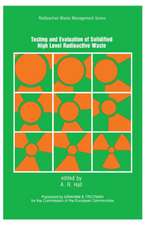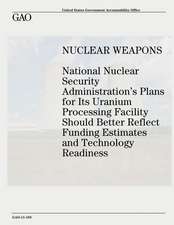Frontiers in Fusion Research II: Introduction to Modern Tokamak Physics
Autor Mitsuru Kikuchi, Masafumi Azumien Limba Engleză Paperback – 28 oct 2016
The tokamak has demonstrated an excellent plasma confinement capability with its symmetry, but has an intrinsic drawback with its pulsed operation with inductive operation. Efforts have been made over the last 20 years to realize steady state operation, most promisingly utilizing bootstrap current.
Frontiers in Fusion Research II: Introduction to Modern Tokamak Physics will be of interest to graduate students and researchers involved in all aspects of tokamak science and technology.
| Toate formatele și edițiile | Preț | Express |
|---|---|---|
| Paperback (1) | 950.33 lei 6-8 săpt. | |
| Springer International Publishing – 28 oct 2016 | 950.33 lei 6-8 săpt. | |
| Hardback (1) | 956.50 lei 6-8 săpt. | |
| Springer International Publishing – 14 sep 2015 | 956.50 lei 6-8 săpt. |
Preț: 950.33 lei
Preț vechi: 1158.95 lei
-18% Nou
Puncte Express: 1425
Preț estimativ în valută:
181.84€ • 190.37$ • 150.46£
181.84€ • 190.37$ • 150.46£
Carte tipărită la comandă
Livrare economică 05-19 aprilie
Preluare comenzi: 021 569.72.76
Specificații
ISBN-13: 9783319353197
ISBN-10: 3319353195
Pagini: 418
Ilustrații: XVI, 402 p. 181 illus., 90 illus. in color.
Dimensiuni: 155 x 235 x 22 mm
Greutate: 0.59 kg
Ediția:Softcover reprint of the original 1st ed. 2015
Editura: Springer International Publishing
Colecția Springer
Locul publicării:Cham, Switzerland
ISBN-10: 3319353195
Pagini: 418
Ilustrații: XVI, 402 p. 181 illus., 90 illus. in color.
Dimensiuni: 155 x 235 x 22 mm
Greutate: 0.59 kg
Ediția:Softcover reprint of the original 1st ed. 2015
Editura: Springer International Publishing
Colecția Springer
Locul publicării:Cham, Switzerland
Cuprins
Introduction to Tokamak Physics.- Steady State Tokamak Reactor.- Steady State Operation of Tokamaks.- Steady State Tokamak Reactor.- Major Features of SSTR.- Reactor Power Balance.- Tokamak Equilibrium.- Topology of Magnetic Confinement.- Symplectic form of the Magnetic Field.- Flux Coordinates.- Equilibrium in Tokamak.- Advanced Tokamak Regimes.- Advanced Tokamak Research.- Weak Shear Regime.- Negative Shear Regime.- Current Hole Regime.- Parallel Transport in Tokamaks.- Moment Equations.- Ohm’s Law in Tokamak.- Plasma Rotation in Tokamak.- Perpendicular Transport in Tokamaks.- Plasma Confinement.- Neoclassical transport.- Turbulent transport.- MHD Instabilities in AT Regimes.- Ideal MHD modes.- Resistive MHD instabilities.- Alfven Eigen Modes.- Control Issues of AT Operation.- Control of ITB strength.- Edge bootstrap current.- Plasma disruption.- SOL and Divertor.- Edge and SOL perpendicular transport.- SOL parallel transport.- Divertor plasma.- Plasma wall interaction.- Key Technology Development for steady state tokamak reactor.- Negative ion source and NBI system.- Gyrotron and ECRF system.- Superconductor and Magnet system.- Structural materials for Fusion.- Blanket and maintenance.- Summary.- Appendix A: Mathematical Basics.- Appendix B: Elementary Physics.- Appendix C: Basic Plasma Physics.
Notă biografică
Dr. Mitsuru Kikuchi is Fusion Research and Development Directorate at Japan Atomic Energy Agency. He is also Guest Professor, Osaka University, Japan; Visiting Professor, Southwestern Institute of Physics, China; Visiting Professor, Modern Physics Institute, Fudan University, China; Visiting Professor, Chinese Academy of Sciences; and Chairman of IAEA's Nuclear Fusion Board of Editor.
He is author of the book "Frontiers in Fusion Research: Physics and Fusion" (Springer 2011)
He is author of the book "Frontiers in Fusion Research: Physics and Fusion" (Springer 2011)
Textul de pe ultima copertă
This book reviews recent progress in our understanding of tokamak physics related to steady state operation, and addresses the scientific feasibility of a steady state tokamak fusion power system. It covers the physical principles behind continuous tokamak operation and details the challenges remaining and new lines of research towards the realization of such a system. Following a short introduction to tokamak physics and the fundamentals of steady state operation, later chapters cover parallel and perpendicular transport in tokamaks, MHD instabilities in advanced tokamak regimes, control issues, and SOL and divertor plasmas. A final chapter reviews key enabling technologies for steady state reactors, including negative ion source and NBI systems, Gyrotron and ECRF systems, superconductor and magnet systems, and structural materials for reactors.
The tokamak has demonstrated an excellent plasma confinement capability with its symmetry, but has an intrinsic drawback with its pulsed operation with inductive operation. Efforts have been made over the last 20 years to realize steady state operation, most promisingly utilizing bootstrap current. Frontiers in Fusion Research II: Introduction to Modern Tokamak Physics will be of interest to graduate students and researchers involved in all aspects of tokamak science and technology.
The tokamak has demonstrated an excellent plasma confinement capability with its symmetry, but has an intrinsic drawback with its pulsed operation with inductive operation. Efforts have been made over the last 20 years to realize steady state operation, most promisingly utilizing bootstrap current. Frontiers in Fusion Research II: Introduction to Modern Tokamak Physics will be of interest to graduate students and researchers involved in all aspects of tokamak science and technology.
Caracteristici
Reviews recent progress in our understanding of the steady state operation of tokamak fusion reactors
Summarizes achievements and challenges from research over the past 20 years
Clarifies key issues for future advanced tokamak researchers
Summarizes achievements and challenges from research over the past 20 years
Clarifies key issues for future advanced tokamak researchers

















